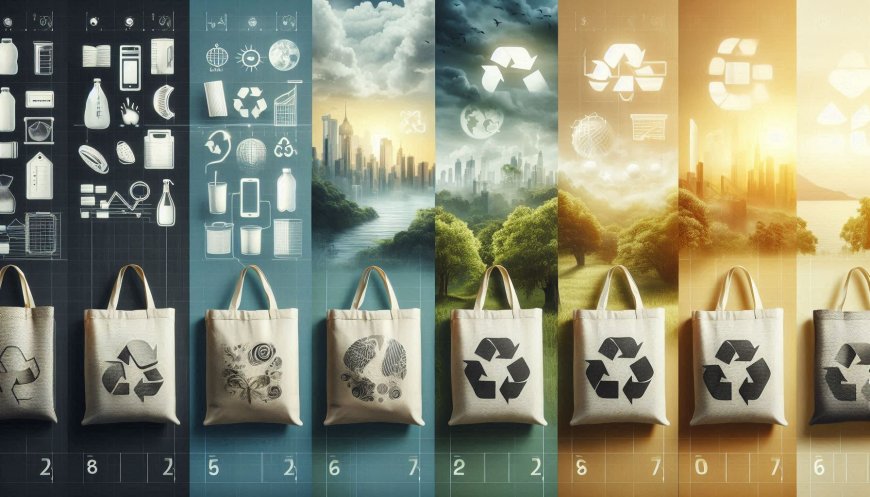The Bag Dilemma: How Many Reuses to Save the Planet?
The Bag Dilemma: Discover how many times you need to reuse plastic, paper, cotton, and tote bags to reduce their environmental impact. Explore the sustainability of different bag types and their role in saving the planet.

As you stroll through the grocery store, reusable bag in hand, you may wonder, "Am I really making a difference?" The answer is more complex than it seems, and recent studies have revealed surprising insights about the true environmental impact of those eco-friendly bags we proudly carry.
It turns out that simply using a reusable bag isn’t enough—it’s how often you use it that truly matters.
The Life of a Bag: A Closer Look
Understanding the environmental footprint of a bag requires a life cycle assessment (LCA), which evaluates each stage of a product’s life—from raw material acquisition to manufacturing, transportation, use, and disposal. This process helps us measure the greenhouse gas emissions, water and energy consumption, waste, and pollution each type of bag generates.
Factors like the material of the bag, its country of origin, and even the decorations printed on it play a role in how eco-friendly it actually is. The stark reality is that not all reusable bags are created equal. Some take far more resources to produce than others, meaning that to truly offset their environmental impact, they need to be reused many times over.
How Many Uses to Go Green?
According to a 2018 study from Denmark, the number of times you need to reuse a bag to match the environmental impact of a single-use plastic bag is staggering:
- Polypropylene bags (the durable, green ones you see everywhere): 37 times.
- Paper bags: 43 times.
- Cotton bags: A jaw-dropping 7,100 times!
These numbers show that while cotton bags may seem like the best choice, they actually require a significant number of reuses to make a true environmental impact, primarily due to the resources needed to grow and process cotton. Even more surprisingly, organic cotton bags carry an even larger environmental burden because of the increased costs of organic farming.
A UK study, focusing specifically on climate change implications, provided slightly more optimistic figures:
- Paper bags should be reused three times.
- Low-density polyethylene (LDPE) bags: Four times.
- Non-woven polypropylene bags: 11 times.
- Cotton bags: 131 times.
While these numbers are more attainable, they still highlight the importance of reusing your bags as much as possible. It’s not enough to just own a reusable bag—it’s how many times you actually bring it to the store that counts.
The Hidden Cost of Forgetting
Even the most eco-conscious shoppers can fall into a common trap: forgetting their reusable bags. A 2014 U.S. study found that roughly 40% of shoppers leave their bags at home, ending up using plastic ones anyway. This not only negates the environmental benefits of their reusable bags but increases their overall environmental impact.
Moreover, the size of the bags you use also affects their footprint. The Danish study made sure to standardize the volume of the bags in their research, meaning that using multiple small bags instead of one large one could be counterproductive.
The Surprising Truth About Sustainability
For those of us who want to live greener lives, these studies reveal some surprising truths. For instance, organic cotton, while marketed as eco-friendly, often has a larger environmental footprint than its non-organic counterpart due to the resources required for production. Similarly, reusable bags adorned with decorative prints may look appealing, but they can add to the bag’s overall environmental cost.
Making Smarter Choices
So, what’s a conscious shopper to do?
- Use your bags often: No matter what material they’re made from, the key is to use them as many times as possible.
- Choose recyclable materials: Bags made from recyclable materials, like polypropylene or LDPE, tend to have a lower environmental toll when reused adequately.
- Keep it simple: Avoid bags with elaborate prints or decorations, as they can increase the environmental burden of the bag.
- Prevent waste: Always find ways to recycle, reuse, or repurpose your bags when they’ve reached the end of their life.
Ultimately, the answer to "How often should I reuse my bag?" is simple—reuse it as often as you can. Every trip to the store with that same trusty bag reduces its overall impact on the planet.
As we navigate our path toward sustainability, it’s not just about the bags we choose—it’s about the conscious choices we make every time we shop. By staying informed and committed, we can each contribute to a greener, more sustainable future.
What's Your Reaction?






































































































